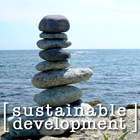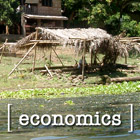
|
NEW STRAIN OF STEM RUST THREATENS WHEAT CROP ACROSS AFRICA, SOUTHERN ASIA UG99 COULD TRAVEL TO ANYWHERE IN THE WORLD IN JUST A FEW YEARS, PUT AT RISK SUSTAINABILITY OF ENTIRE GLOBAL WHEAT HARVEST 6 June 2007 A new strain of wheat-eating stem rust has emerged as a threat to the global food supply. Ug99, named for the place and date of its discovery, Uganda, 1999, takes advantage of weaknesses in wheat varieties which were specifically developed to be resistant to stem rust, and which have been so for nearly 4 decades. What now looks like it could be a dangerous "super-blight", spreading rapidly from region to region and mutating to affect each new country it visits, comes at a time when the wheat harvest itself is already stressed to the breaking point. in 6 of the last 7 years, consumption has outpaced production, meaning that reserves are at 35-year lows. The price of wheat increased an estimated 14% overall last year, meaning that one of the world's major food-staples has become an economic stressor in a time when population growth, armed conflict, migration, climate change and water-shortages make it all the more difficult to withstand. A stem rust pandemic could bring on serious economic and social degradation in the most harvest-dependent societies. Economic and political instability could also follow in wealthier countries, as prices pressure consumers, governments and producers to come up with viable solutions to a cost-driven crisis. CIMMYT, the Centro Internacional para el Mejoramiento del Maíz y del Trigo, where the first rust-resistant varieties of wheat were bred and mass-produced, is now investing intensified time and resources to the problem of creating a new Ug99 resistant seed. The disease has already spread from wheat crops in Uganda and Kenya, north to the Sudan and across the Red Sea to Yemen, and is expected to soon arrive in Iran, Pakistan, Afghanistan and India, where it will put the food supply of one billion people in jeopardy, if a solution is not found soon. There are new varieties of wheat available, and which are undergoing field testing in Kenya and Ethiopia, where Ug99 is already present in the environment. Some 27 fields in Nepal, India, Afghanistan and Pakistan have been planted with successful Ug99-resistant seeds, in hopes of expanding the numbers of seeds available without giving the fungus a chance to evolve new strategies for circumventing resistance. It is expected it will take 5 to 8 years before enough seed can be produced to protect the world's food supply with the new wheat varieties. What's more, each time the fungus reaches a new agricultural environment, it encounters new environmental competitors and breeds in distinct ways, producing evolved strains that may not be susceptible to the restistant wheat's defenses. The last outbreak of stem rust in North America, in 1954, "wiped out 40 percent of the crop", according to the New Scientist magazine. The fear with Ug99 is its own capacity for circumventing resistance: Rick Ward, of CIMMYT, has said "Of the 50 genes we know for resistance to stem rust, only 10 work even partially against Ug99". Those 10 genes are found in only 1% of the global wheat crop at present. [s]
BACKGROUND: Investment in fuel ethanol distilleries has soared since the late-2005 oil price hikes, but data collection in this fast-changing sector has fallen behind. Because of inadequate data collection on the number of new plants under construction, the quantity of grain that will be needed for fuel ethanol distilleries has been vastly understated. Farmers, feeders, food processors, ethanol investors, and grain-importing countries are basing decisions on incomplete data. [Full Story] WORLD’S WATER RESOURCES FACE MOUNTING PRESSURE Global freshwater use tripled during the second half of the twentieth century as population more than doubled and as technological advances let farmers and other water users pump groundwater from greater depths and harness river water with more and larger dams. As global demand soars, pressures on the world’s water resources are straining aquatic systems worldwide. Rivers are running dry, lakes are disappearing, and water tables are dropping. Nearly 70 percent of global water withdrawals from rivers, lakes, and aquifers are used for irrigation, while industry and households account for 20 and 10 percent, respectively. [Full Story] SUPERMARKETS & SERVICE STATIONS NOW COMPETING FOR GRAIN Cars, not people, will claim most of the increase in world grain consumption this year. The U.S. Department of Agriculture projects that world grain use will grow by 20 million tons in 2006. Of this, 14 million tons will be used to produce fuel for cars in the United States, leaving only 6 million tons to satisfy the world’s growing food needs. [Full Story] WORLD GRAIN STOCKS FALL TO 57 DAYS OF CONSUMPTION This year’s world grain harvest is projected to fall short of consumption by 61 million tons, marking the sixth time in the last seven years that production has failed to satisfy demand. As a result of these shortfalls, world carryover stocks at the end of this crop year are projected to drop to 57 days of consumption, the shortest buffer since the 56-day-low in 1972 that triggered a doubling of grain prices. [Full Story] NORWAY TO BUILD ARCTIC SEED BANK The Norwegian government has announced plans to create a global seed bank, to be located in the nation's arctic subsoil, to preserve all world crop varieties against extinction, should any number of natural disasters strike. The seed bank will be located inside a frozen mountain on the island of Spitsbergen, in the Svalbard archipelago in the Arctic Ocean. [Full Story] |
|||||||||||||||||
|
||||||||||||||||||







